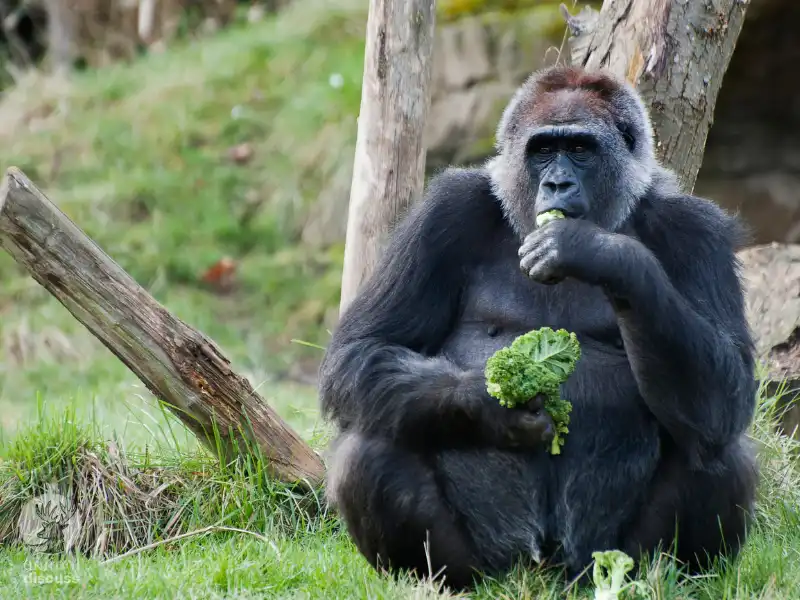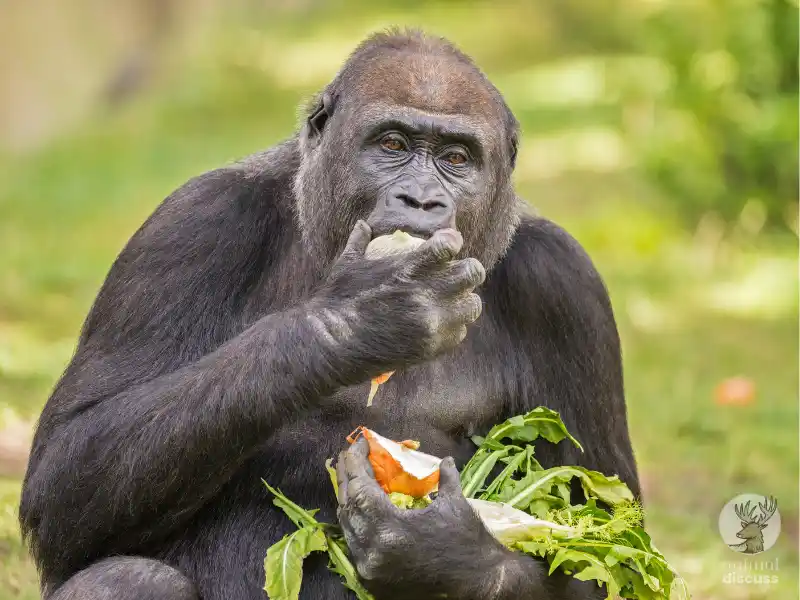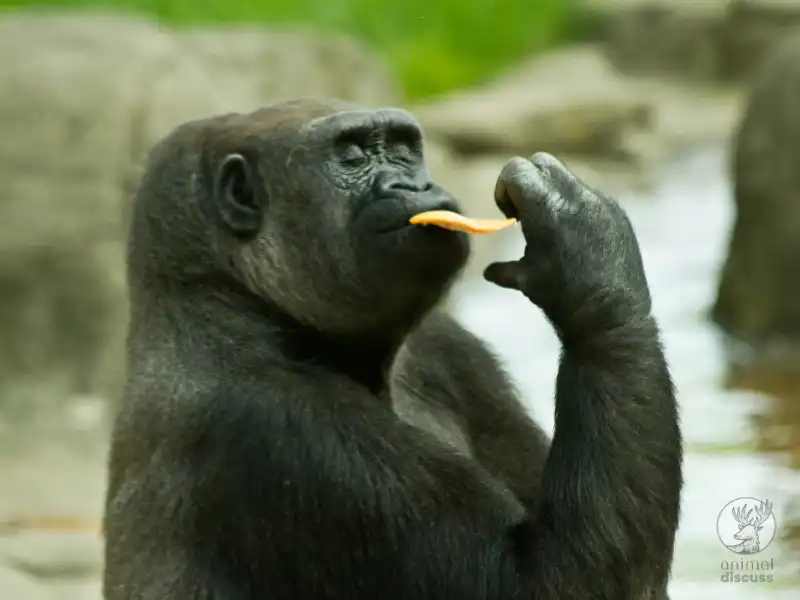Gorillas are the largest living primates that live in Africa. They have 98% of DNA similarity with Humans. Knowing their enormous size and remarkable strength, you might wonder what the diet of these “gentle giants is”.
The Gorillas are omnivores, but they primarily stick to vegetarian diets. They eat leaves, barks, piths, roots and stems of different plants. Their diet also includes various fruits and herbs. Some gorillas also eat insects.
In this article, I will discuss the diet of different species of gorillas. I will also discuss their diet in captivity and also various eating behaviors of gorillas.
What Food Do Gorillas Eat?
As I said, Gorillas are omnivorous, they can eat plants, insects and meat. However, in their natural habitat gorillas mainly eat vegetation. Besides, the diet of gorillas varies among the species.

Let’s look deep into the eating habits of different types of gorillas.
| Species | Diet |
|---|---|
| Eastern Lowland Gorilla | Mainly vines, herbs and some trees |
| Western Lowland Gorilla | Mostly fruit, leaves, seeds, and stems of plant, plus some termites and caterpillars |
| Cross River Gorilla | Fruit, leaves, stems, and piths of plants |
| Mountain Gorilla | Leaves, shoots, and stems of at least 142 plant species, with some roots, flowers and fruit |
Primarily, mountain gorillas are folivores. The main foods they eat are leaves, stems, and vines. 68% of the intake comes from leaves, 25% from the stem, 5% from the pith, and 1.4% from the epithelium from the roots. The remaining 4% is from the bark, roots, flowers, and fruit.
Likewise, the mountain gorilla eats up to 200 different plant species, but they are quite picky. They eat only specific sections of the plants at specific periods of the year.
Compared to mountain gorillas, the diet of eastern lowland gorillas seems to be more similar to that of western lowland gorillas. The eastern lowland gorillas eat leaves, pith, and fruits. 25% of their food intake is fruits.
Western lowland gorillas eat more fruit, although the majority of its diet still consists of green plants. According to studies, 23% of their food intake is vines, 38% are herbs, 24% are saplings, and 15% are trees. They also sometimes eat insects such as ants and caterpillars.
The cross river gorillas eat different types of fruits, leaves and stems of trees. They eat more liana and tree bark than the western lowland gorillas. [Reference 1]
Curious to learn about Gorilla! Explore this article.
How Gorillas Forage Food?
Gorillas are selective eaters and select the ripest and most nutritious parts of trees and fruits. So, how do these animals selectively choose nutritious food? They identify edible food in the wild by using the senses of smell, touch, and sight.
First and foremost, their well-developed vision helps them to differentiate color. They find the ripe fruits with the help of their vision. Besides, they have binocular vision that allows them to precisely measure distances and travel their habitat.
In addition, they identify edible fruits and vegetation with the help of their sense of smell and taste. They explore their food with their delicate fingertips. This helps them choose which portions of plants are ideal to eat. And with the help of their agile lips and hands, they eat the parts they want.
Eating Behavior of Gorilla
You might wonder what amount of food the largest living primates have to eat. The gorillas eat large amounts of food because they only depend on vegetation. Male gorillas eat 40lb of food per day which is about 20% of their body weight.

Another interesting characteristic of gorillas is that they never feed from a single part of the plant or the forest. After consuming one portion of a plant, a gorilla will switch to the other plant. In this way, gorillas manage to preserve their own food supplies in an intelligent manner.
Again, you might not see a gorilla drinking water for several hours. Like other animals, gorillas require water in their bodies. But they drink less water. One reason is that their diet of fresh fruits, shoots, and leaves provides for a large portion of their water requirements.
How Do Gorillas Get Protein in Their Diet?
Gorilla’s diet is mainly vegetation. So, you might wonder how gorillas are so big and where they get the protein in their diet. Gorillas get their protein from the leaves and stems of trees. They prefer to consume the younger leaves since they are higher in protein and lower in fiber.
Similarly, gorillas produce their own protein. The big gut of gorillas has elongated intestines. In the long intestines, the plants’ cellulose has an opportunity to ferment. The fermentation process produces microorganisms that are rich in protein. [Reference 2]
Factors Influencing Gorillas’ Diet
Gorilla’s diet is influenced by the regions they live in. Their habitats are different types of forests such as lowland, montane, and bamboo forests. Gorillas that live in lowlands consume more fruits than the gorillas that live in bamboo and montane forests.
Their diet also varies based on their age. Young gorillas eat more foods and select foods that have more minerals. A study in a National Park in Uganda shows that the juveniles eat more leaves with high minerals.
Moreover, the female gorillas during pregnancy eat more fruit and bamboo shoots. These foods are rich in carbohydrates and water, which will help them support their offspring’s growth.
The diet of gorillas also changes during different seasons. For instance, during the wet season, gorillas mostly rely on different types of fruits. Conversely, in the dry season, gorillas eat the leaves, bark, and roots of plants and different herbs.
What Food Gorillas Eat in Captivity?
Gorilla’s diet in captivity differs from their diet in the wild. In zoos, gorillas’ diets and overall health are regularly assessed and modified based on their particular condition.
The diet of Gorillas in captivity includes high-fiber primate biscuits, ants, termites, fruits, stems, and shoots. At least 60% of the meal consists of leafy vegetables, with the rest ingredients sharing the remaining portion.

In addition, Gorillas feed on grubs, and larvae in some zoos to fulfill their protein requirement. Certain zoos additionally offer gorillas animal products such as yogurt, milk, eggs, and meat.
However, a study says that captive gorillas and westernized humans are similar in that they are removed from their native diet. This consequently puts them at risk for certain illnesses.
Frequently Asked Questions
Here are some frequently asked questions about the food and diet of gorillas.
Do Gorillas eat bananas?
No, Gorillas do not eat bananas. Although they eat different types of fruit, their diet does not include bananas. One reason is that in their natural habitat, gorillas do not have access to banana plants.
Why do gorillas eat their own feces?
Gorillas eat their own feces for several reasons such as out of boredom or to re-ingest seeds found in their excrement. This behavior might also indicate the lack of nutrients in their diet.
How much time does a gorilla spend eating per day?
Gorillas are huge in size and their diet mainly consists of vegetation. So, they need a huge amount of food for survival. They spent their half of the day eating food.
Conclusion
Gorillas are mainly vegetarian. Their diet mainly consists of leaves, flowers, stems, roots, and fruits. You might also find gorillas eating insects such as ants, caterpillars, etc. However, the amount of insects eating is very low, only 1% of their diet.
In addition, gorillas have some interesting eating behavior such as they do not eat whole plants rather, they eat parts of different plants. In this way, these giants preserve their food supplies.
Their diet is influenced by season and habitat, age, and sex. The diet of gorillas kept in captivity also differs from their diet in the wild.
References
- https://seaworld.org/animals/all-about/gorilla/diet/
- https://www.berggorilla.org/en/gorillas/general/everyday-life/what-do-gorillas-eat/
- https://nationalzoo.si.edu/animals/news/day-life-gorilla-smithsonians-national-zoo
- https://www.wwf.org.uk/learn/fascinating-facts/gorillas
- https://www.researchgate.net/publication/265157992_Gorilla_Nutrition

